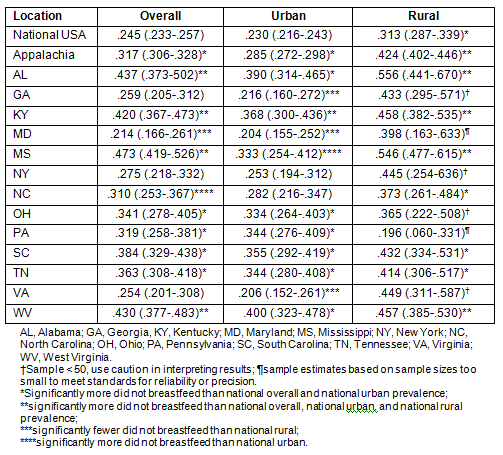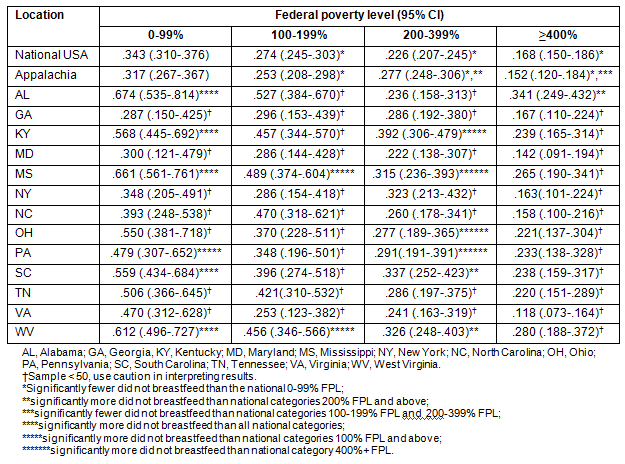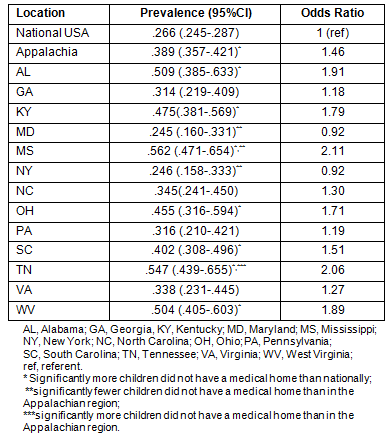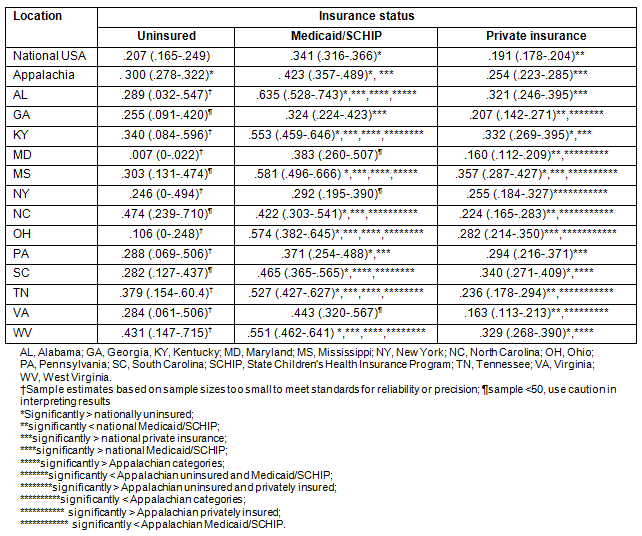Benefits of breastfeeding
There are many known infant health benefits related to exclusive breastfeeding, including nutritional, developmental, psychological, neurological, social, environmental, and immunological benefits1. Exclusive breastfeeding has been shown to decrease the incidence or severity of bacterial meningitis, bacteremia, diarrhea, respiratory tract infection, necrotizing enterocolitis, otits media, urinary tract infection, late-onset sepsis in preterm babies, lymphoma, leukemia, Hodgkin disease, hypercholesterolemia, asthma, as well as reduce post-neonatal infant mortality1. Exclusive breastfeeding has also been reported to be protective against obesity (odds ratio [OR] 0.75)1-3. Breastfeeding has been associated with higher cognitive development of the child1 and higher Weschler scores in adulthood4. Similarly, breastfeeding mothers benefit by having decreased postpartum bleeding, an earlier return to their pre-pregnancy weight, and a decreased risk of breast and ovarian cancer1. Although the American Academy of Pediatrics and WHO recommend exclusive breastfeeding for 1 year, there are benefits to the infant of breastfeeding during the first few days of life in which antibody-rich colostrum is provided, and intimate bonding occurs with the mother.
Goals in 'Healthy People 2020'
Although there are recognized health benefits for infants and mothers through breastfeeding, many women choose not to breastfeed their infants. The US Government 'Healthy People 2020' agenda has a target of a breastfeeding prevalence of 0.819, which corresponds to an 8% improvement over the 2006 baseline of 0.7395. Intervention strategies to promote breastfeeding have been successful in many settings6. However, culturally sensitive awareness programs and interventions directed at the populations of specific geographic areas may be needed to improve the prevalence of breastfeeding7.
Rural Appalachia breastfeeding prevalence
The Appalachian Region is a 329916 km2 (205 000 miles2) area, 42% of which is rural. It follows the Appalachian Mountains in 13 states: New York, Pennsylvania, West Virginia, Maryland, Ohio, Virginia, Kentucky, Tennessee, North Carolina, South Carolina, Alabama, Georgia and Mississippi8. Appalachia is home to 24.8 million people, 18% of whom live in poverty8. Much of the mountainous region is geographically isolated and approximately 50% of Appalachia's 410 counties had fewer than 30 000 people in 20009. The rural area has rolling hills, and rapidly rising ridges to over 1220 m (4000 feet) with remote valleys10. There are isolated, secluded communities in the hills and hollows, and this isolation has forged family and community cohesiveness10. Some communities have been able to thrive, grow and develop; while for others, the isolation has resulted in the continued absence of basic infrastructure (roads, water, sewage) and access to health care and support8.
Support and aid during the initiation of breastfeeding have been identified as important factors for mothers to decide to breastfeed11,12; however, in rural Appalachia there are few resources to offer this. Socioeconomic factors, such as the need to return to work and limited maternity have also been related to breastfeeding decisions13. Additionally, and specific to rural Appalachia, pregnant women with a low socioeconomic level also have a high prevalence of smoking morbidity14. There is a negative association of maternal smoking with breastfeeding intention, initiation, and duration13. For Appalachian women, access to health professionals, socioeconomics and rural living may impact breastfeeding decisions. Therefore, it is important to know if the rates of breastfeeding are higher or lower in Appalachia, as a preliminary to assessing needs for health services or behavioral intervention.
Previous studies have indicated a low breastfeeding prevalence in the southern region of the USA11. Direct comparisons between urban and rural women and their differences in breastfeeding initiation have been infrequently explored12. A more refined analysis for the Appalachian Region was needed. The purpose of this study was to examine for differences in the national and Appalachian prevalences of breastfeeding in rural and urban settings, and to identify health care and socioeconomic factors that may impact on this.
The 2007 US National Survey of Children's Health (NSCH) data was used for this study15. Because the database is on open access and personal identifiers are removed, the study did not require institutional review board approval for this secondary data analysis.
The data collection was sponsored by the Maternal and Child Health Bureau and the Department of Health and Human Services15. The Centers for Disease Control and Prevention's National Center for Health Statistics oversaw the sharing of its resource, the State and Local Area Integrated Telephone Survey Program (SLAITS) of the National Center for Health Statistics (in which computer assisted telephone interviews were used to contact 1 million US households to screen for childhood immunization and collect age-eligible health information)15. The SLAITS collected all land-line telephone numbers, applied a majority rule of 50% for directory listings to identify estimation areas, and created banks of 100 consecutive telephone numbers with prefix areas assigned. To adjust for those without a land-line, homes with an interrupted telephone service were targeted as being representative of those with no land-line and were weighted in the final analysis. Within the estimation areas, the sample was segmented into representative sub-samples that were updated quarterly15. The software removed known businesses, numbers listed on the 'do not call list' and duplicates. Participant addresses were obtained by reverse matching, and advance letters were mailed.
Phone calls were made with at least 6 repeat calls to increase the response rate. In areas where the SLAITS samples were low, additional samples were drawn independently. The samples were weighted to be representational of the population. The overall response rate was 46.7%; and the alternate resolution rate was 89.9%, which corresponds with 6 or more calls on different days at different times resulting in no answer, or a busy signal, being considered non-working or non-residential15.
Eligible participants were parents or guardians of children living in the home aged 0-18 years. There were 91 642 child-level interviews completed from April 2007 to July 2008, with a mean of 22:55 min and median of 21:54 min per interview15. The interviewers were trained in the administration of the survey by the National Opinion Research Center. Interviews were conducted in English or Spanish (there are Spanish-speaking migrant farm workers throughout Appalachia). Consent was obtained at the interview, which was conducted with the parent or guardian and one randomly selected child aged 0-18 years who was living in the home. Questions in section 6 of the survey were asked of all children living in the household who were aged 0-5 years. There were at least 1700 participants per state (91 642 nationally) and the overall survey results were weighted to be representative of the non-institutionalized children aged up to 18 years. There were 27 388 interviews concerning children ages 0-5 years. Less than 1% of the data were excluded due to no response, refusals, or responses of 'don't know', unless otherwise noted in the 'Data Users' section of the database. Details are available elsewhere15.
A surveyed parent or guardian of a child aged 0-5 years was asked: 'Was [child's name] ever breastfed or fed breast milk?' The outcome variable, breastfeeding, was defined as a positive response the question, and not breastfeeding was defined as a negative response. The variable, rural/urban designation, was based on the Rural Urban Commuting Area taxonomy which uses census tract and/or zip code to identify urban and rural areas with an algorithm, including population density and population work commuting patterns15. Socioeconomic and demographic data were obtained for Federal Poverty Level (FPL) status, medical home (a source of comprehensive primary care) status, and insurance status. Appalachia was defined as the state level for protection of the participant, because release of the estimation areas could potentially identify remote rural participants. The states included were West Virginia (WV), Kentucky (KY), New York (NY), Pennsylvania (PA), Maryland (MD), Ohio (OH), Virginia (VA), Tennessee (TN), North Carolina (NC), South Carolina (SC), Alabama (AL), Georgia (GA) and Mississippi (MS).
The Data Resource Center for Child and Adolescent Health, supported by the Maternal Child Health Bureau of the Health and Human Services, provides the NSCH as an open access database to advance the effective use of public data on health and health related services for children, youth and families15. The Data Resource Center for Child and Adolescent Health provides an online, user-friendly data query tool based in SAS (http://www.sas.com) analysis to query the data base for prevalence data with CIs, and limited multivariate data analysis. No re-coding of variables was completed15. The database was queried with the SPSS (http://www.spss.com) Complex Samples software online query tool for breastfeeding prevalence, utilizing national and state data. Options were selected from the online query tool's menu for rural and urban status; Federal Poverty Level (FPL), medical home status, and insurance status. The Data Resource Center thus makes the analysis standardized, repeatable, and available to all researchers providing Taylor linearization methods to calculate variance estimates for proportions, which are in turn used to construct 95% CIs using standard statistical formulas (K Newton; pers. comm., 2011).
Of the 91 642 national interviews conducted for the 2007 National Survey of Children's Health, there were 27 388 children aged 0-5 years for whom survey information was obtained. The weighted US point prevalence of breastfeeding was 0.755 (CI 0.743-0.767); for Appalachia it was 0.683 (CI 0.672- 0.694). Rural and urban prevalences were weighted to reflect population densities. The national urban areas had a prevalence of breastfeeding of 0.770 (CI 0.757-0.784); for Appalachia it was 0.715 (CI 0.702-0.728). Nationally, rural areas had a significantly lower prevalence of breastfeeding of 0.687 (CI 0.661-0.713), and for Appalachia it was 0.576 (CI 0.554-0.598). None of the states in Appalachia had a prevalence of breastfeeding above the national rural prevalence or national urban prevalence. In the Appalachian states of WV, KY, AL, and MS, the prevalence of rural women who breastfed was significantly less than the national rural prevalence. In the states of TN, NC, SC, PA, NY, VA, OH, GA and MD, the prevalence was the same as the national rural prevalence. (Small sample sizes of <50 women were found in PA, NY, VA, OH, GA, and MD. Precision for population estimates is influenced by sample size, and if <50 women the 95% CI range may be too large for the standard of reliability15). The prevalence of women who breastfed and lived in urban areas of Appalachia was significantly less than the national urban prevalence in the states of WV, KY, TN, PA, OH, SC, AL, and MS. The prevalence was the same as the national urban prevalence in NY, VA, NC, GA, and MD (Table 1).
Nationally, 34.3% (CI 31.0-37.6) of women at 0-99% of the FPL did not breastfeed. The percentages for not breastfeeding were 27.4% (CI 24.5-30.3) at 100-199% FPL; 22.6% (CI 20.7-24.5) at 200-399% FPL; and 16.8% (CI 15.0-18.6) at 400% and above FPL. Of the Appalachian states with sample sizes above 50 women, all FPL categories with no breastfeeding were equivalent to or had more women who did not breastfed than nationally. There were significantly more women who did not breastfeed and were at 0-99% FPL in WV, KY, SC, AL, and MS, compared with the national level. There were significantly more women who did not breastfeed and were at 100-199% FPL in WV, and MS. There were significantly more women who did not breastfeed and were at 200-399% FPL in WV, KY, and SC. There were significantly more women who did not breastfeed and were at 400% and over FPL in AL (Table 2).
Table 1: Prevalence of women who did not breastfeed (95% CI)15

Table 2: Prevalence of women who did not breastfeed at Federal Poverty Levels (95% CI)15.

Nationally, 26.6% (CI 24.5-28.7) of the children of women who did not breastfeed also did not meet all criteria for having a medical home. In Appalachia, with sample sizes above 50 women, WV, KY, TN, OH, SC, AL, and MS had significantly higher percentages of children of women who did not breastfeed who also did not meet the criteria for having a medical home, compared with the national percentage. In PA, GA, and NC, the percentage was higher, but within the confidence level of the national percentage; and in NY the percentage was lower, but within the confidence level of the national prevalence (Table 3).
The prevalence of not breastfeeding in the uninsured or privately insured women was (0.207 CI 0.165-0.245) for uninsured and 0.191(CI 0.178-0.204) for privately insured; whereas, the women who had Medicaid/State Children's Health Insurance Program (SCHIP) had a prevalence of not breastfeeding of 0.341 (CI 0.316-0.366). Women who had Medicaid/SCHIP had an OR of 1.65 of not breastfeeding, compared with uninsured women; and an OR of 1.79 compared with privately insured women. Of the Appalachian states with sample sizes greater than 50 women, the prevalence of women who had Medicaid/SCHIP and did not breastfeed was higher than the national level for WV, KY, TN, AL and MS. The prevalence of not breastfeeding among women with Medicaid/SCHIP was within the confidence levels of the national prevalence for all of the other Appalachian states. The women who had private insurance and did not breastfeed in WV, KY, SC, AL, and MS had a significantly higher prevalence of not breastfeeding than the national level. The prevalence of not breastfeeding among women who had private insurance was within the confidence levels of the national prevalence for the other Appalachian states. There were too few women who were uninsured who were sampled in the Appalachian states to compare with the national statistic on prevalence of uninsured and not breastfeeding (Table 4).
Table 3: Prevalence of women who did not breastfeed and did not have all of the criteria of medical home met for children ages 0-5 (95%CI)15

Table 4: Prevalence of women who did not breastfeed and were uninsured, had Medicaid/State Children's Health Insurance Program, or had private insurance (95% CI)15

Discussion
This study shows that the national breastfeeding prevalence has increased from 20066. Nevertheless, rural areas, and particularly rural areas in Appalachia, had more women who did not breastfeed. This supports previous research that suggested initiation of breastfeeding may be more frequent among urban women11. Rural children had an OR of 1.28 of not being breastfed , compared with the USA overall. The children in rural Appalachia had an OR of 1.73 of not being breastfed , compared with the USA overall, and 1.35 compared with children in other rural areas of the USA.
The major strengths of the study are its national population-based design and large overall sample size. There were some limitations. The outcome variable, breastfeeding, was self-reported and thus there was a possibility of misclassification bias from a self-report error. Because the respondent self-reported a home address there was a possibility of misclassification bias relating to rural or urban location due to a self-report error. The study was cross-sectional, so inferences about risk should not be made; and in several analyses the sample sizes were small, therefore caution should be exercised with their interpretation. Participants had to have land-line telephones to be included in the study. As the number of people who are using cellular phones increase, the effectiveness of random digit dialing surveys becomes limited. This survey design attempted to weight participants who had interrupted phone service so as to adjust for those who did not have land-lines. The overall response rate was low, but adjusting for no answers, or busy signals after 6 or more attempts resulted in an alternate resolution rate of 89.9%15.
This research indicates the significant impact of medical home, FPLs, insurance availability and living in rural Appalachia on breastfeeding rates. Other determinants also exist. Of the limited research that addresses factors that impact on a decision to breastfeed, partner influence has been shown to be an important factor in improving breastfeeding rates16. Some women report inflammation, soreness, tenderness, Candida infection, low milk supply, or the baby's colic as reasons to choose not to breastfeed17. Urban women who had support from the healthcare system12, and foreign-born women who emigrated to the USA were more likely to decide to breastfeed18. Women whose pregnancies were unplanned were more likely to decide against breastfeeding19. Urban women who developed postpartum depression were more likely to decide against breastfeeding20. Women who intended to work when their child was 2 months old, and women who participated in the US Federal Women, Infants, and Children program were more likely to decide against breastfeeding12. Qualitative research is needed to explore the other factors influencing the intention to breastfeed or not.
Little research is available about barriers that specifically dissuade rural women12, and women in Appalachia in particular, from breastfeeding. It has been reported that additional potential factors impacting the decision of rural women to breastfeed are geographic isolation, few economic resources, limited access to health care, and smoking, which may be similar or distinct from the factors influencing urban women in their decisions12,14.
There are also limited applications of behavioral science theories to breastfeeding research and frameworks from which to develop educational strategies that would modify factors involved in women deciding to initiate breastfeeding12. Before anticipatory guidance with culturally sensitive awareness programs and interventions can be effectively developed and disseminated, it is important to have a series of focus groups to qualitatively determine factors that may be culturally specific and influential for women in Appalachia. This would assist in formulating objectives to meet the needs of Appalachian women who decide to breastfeed.
Increasing the prevalence of breastfeeding is a national US objective. Rural areas, and rural Appalachia in particular, are lagging behind the rest of the nation in meeting the objective. The identification and removal of barriers are needed for this population. Future research should involve exploration and explanation of these barriers.
Acknowledgement
The views expressed in this article do not necessarily represent the views of the USP Hazelton Dental Service Unit, Bureau of Prisons, Department of Justice, or the US Government.
References
1. Gartner LM, Morton J, Lawrence RA, Naylor AJ, O'Hare D, Schanler RJ et al. Policy statement, Breastfeeding and the Use of Human Milk, section on breastfeeding. Pediatrics 2005; 115: 496-506.
2. von Kries R, Koletzko B, Sauerwald T, von Mutius E, Barnert D, Grunert V et al. Breastfeeding and obesity: cross sectional study. BMJ 1999; 319: 147-150.
3. Harder T, Bergmann R, Kallischnigg G, Plagemann A. Duration of breastfeeding and risk of overweight: a meta-analysis. American Journal of Epidemiology 2005; 162: 397-403.
4. Mortensen EL, Michaelsen KF, Sanders SA. The association between duration of breasatfeeding and adult intelligence. JAMA 2002; 287: 2865-2372.
5. US Government. Maternal, infant, and child health. Objective MICH-21, Increase the proportion of infants who are breastfed. In: Healthy People 2020. (Online) 2010. Available: http://www.healthypeople.gov/2020/topicsobjectives2020/objectiveslist.aspx?topicid=26 (Accessed 26 December 2010).
6. Kramer MS, Chalmers B, Hodnett ED, Seykoyskaya Z, Dzikovich I et al. Promotion of breastfeeding intervention trial (PROBIT): a randomized trial in the Republic of Belarus. JAMA 2001; 285: 413-420.
7. Philipp BL, Malone KL, Cimo S, Merewood A. Sustained breastfeeding rates at a US Baby-Friendly hospital. Pediatrics 2003; 112: e234-e236.
8. Appalachian Regional Commission. The Appalachian Region. (Online) 2010. Available: http://www.arc.gov/appalachian_region/TheAppalachianRegion.asp (Accessed 27 December 2010).
9. Pollard KM. Demographic and socioeconomic changes in Appalachia: population growth and distribution in Appalachia. Washington, DC: ARC Population Reference Bureau, 2010. Available: http://www.arc.gov/assets/research_reports/PopulationGrowthandDistributioninAppalachia.pdf (Accessed 24 February 2011).
10. Huttlinger K, Schaller-Ayers J, Lawson T. Health care in Appalachia: a population based approach. Public Health Nursing 2009; 21: 103-110.
11. Chertok IRA, Luo J, Culp S, Mullet M. Intent to breastfeed: a population-based perspective. Breastfeeding Medicine 2010; DOI: 10.1089/bfm.2010.001.
12. Flower, KB, Willoughby M, Cadigan RJ, Perrin EM, Randolph G. Understanding breastfeeding initiation and continuation in rural communities: a combined qualitative/quantitative approach. Maternal and Child Health Journal 2008; 12: 402-414.
13. Scott JA, Binns CW, Graham KI. Predictors of breastfeeding duration: evidence from a cohort study. Pediatrics 2006; 117: e646-e655.
14. Song H, Fish M. Demographic and psychosocial characteristics of smokers and nonsmokers in low socioeconomic status rural Appalachia 2 - parent families in southern West Virginia. Journal of Rural Health 2006; 22: 83-87.
15. Child and Adolescent Health Measurement Initiative. 2007 National Survey of Children's Health. (Online) no date. Available: http://childhealthdata.com/content/Default.aspx (Accessed 27 December 2010).
16. Rempel LA, Rempel JK. Partner influence on health behavior decision-making: increasing breastfeeding duration. Journal of Social and Personal Relationships 2004; 21: 92.
17. Grayson C. Common breastfeeding problems. WebMD. (Online) 2003. Available: http://www.medicinenet.com/script/main/art.asp?articlekey=52268 (Accessed 24 February 2011).
18. Gibson-Davis CM, Brooks-Gunn J. Couples' immigration status and ethnicity as determinants of breastfeeding. American Journal of Public Health 2006; 96: 641-646.
19. Dye T, Wojtowycz MA, Aubry RH, Quade J, Kilburn H. Unintended pregnancy and breastfeeding behavior. American Journal of Public Health 1997; 87: 1709-1711.
20. Paulson JF, Dauber S, Leiferman JA. Individual and combined effects of postpartum depression in mothers and fathers on parenting behavior. Pediatrics 2006; 118: 659-668.
